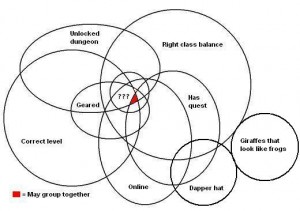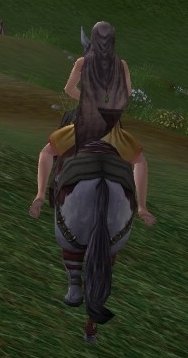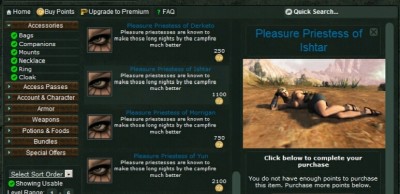A while back I took a quick run-through the housing options in some MMOGs over the years, something I’ve been thinking about again as I’ve just bought three houses. Well, one rented room, a house and a moonbase, to be strictly accurate, in Fallout: New Vegas, Lord of the Rings Online and Champions Online respectively.
I finally cracked on the last day of the recent Steam summer camp and picked up New Vegas and its first two DLC packs. News of a hefty patch with many bug fixes and performance improvements at the start of the month sounded promising, and an example of the benefits of the three (or indeed nine) month rule, though I’ve still encountered one minor glitch in a side quest that needed a bit of frinking to sort out. I really enjoyed Fallout 3, up until the end felt a bit rushed, and New Vegas is pretty much more of that, which works for me. I’m not very far into the game, not even having made it to the titular New Vegas yet, but I’ve just secured a motel room in Novac and that means I can get on with with my primary objective: exploring random locations and grabbing everything that isn’t nailed down (and if it is nailed down finding a crowbar to pry it loose); weaponry, clothing, food, medicine, scrap metal, pilot lights, lunchboxes, paint guns, detergent, gecko hide, shoes, lightbulbs, zeppelins… Then loading myself and a companion up with as much as we can carry, taking it back to the motel room and storing it in a cupboard in case it’s useful sometime, where it almost inevitably stays ’til the end of the game. Still, if there’s a quest objective that needs two pieces of ant meat, a packet of irradiated breakfast cereal, a souvenir dinosaur and a frying pan, I’m ready!
Over in Middle Earth I’ve only just got around to buying a house in Lord of the Rings Online. Again it’s largely driven by my hoarding instincts that make it terribly difficult to throw anything away, so having filled up the maximum 120 slots of my main character’s vault storage I decided it would be quite handy to get an additional storage chest in a house, and also have somewhere to put some of the bound furnishings that I couldn’t pass to Bank Alt #7. Each of the four races has its own housing area with a distinctive style so I took a bit of a tour, and it became apparent that the housing brokers have adopted the Budget Airline Airport Naming Scheme (e.g. Frankfurt-Hahn Airport, a mere 120km from Frankfurt); to get to the Thorin’s Hall housing you go out the main doors, down the steps, past the stablemaster and round the corner (via a couple of miffed goblins), and as for the Elven area in Rivendell West (nr. Duillond)… I picked out a Dwarven house in the end, ran through a couple of quick introduction quests that resulted in some furniture rewards, and settled in.
The LotRO furnishing system is a bit more limited than that of EQ2; you can select a texture and a colour for walls and floor, then place items in designated areas (e.g. Large Wall, Small Floor, Medium Sized Outside Bit). Fulfilling my primary goal of “offloading any furnishings I’d happened to acquire” has resulted in a somewhat eclectic decoration scheme that would be a bit weird even for Laurence Llewelyn-Bowen; one room features a frame on the wall containing the dress of the Red Maid (maybe that was taking “stripping the corpse of loot” a bit far), a freaky undead banner thing in a corner, and a single chair. The other room has a mouse-hole in one wall (with a large block of cheese in front of it) and a dead bear on the floor. I’d be worried by what the neighbours would think, if it wasn’t for the fact that it only rates about 0.4 on the weird-shit-o-meter of what LotRO adventurers furnish their houses with; I got groped by a tentacle the last time I was in the kin house!
LotRO houses are in their own instances, with multiple copies of the instance available to facilitate everyone having their own house without paving over the entire Shire. Combined with being stuck out a way from the main towns it makes the areas feel a bit like suburbia, and together with a widespread and efficient public transport service you get something that doesn’t quite gel with the setting. Homes generally feature in fantasy tales as somewhere to tearfully leave at the beginning of an epic adventure, or a place to run away from when you discover the magical heritage from your true parents, or somewhere that gets burnt to the ground resulting in a sworn oath of revenge. Rather less frequently homes are somewhere the protagonist commutes from; “oh fiddlesticks, I’ll miss the 8:17 horse from Bree if I don’t get a move on darling. Important meeting in Garth Agarwen today, I should be back for six o’clock but you know that Ivar the Bloodhand, once he starts monologuing you just can’t shut him up, I’ll swing past the provisioner on the way home and pick us up some tasty rations for dinner, mwah, mwah, see you later.” That’s not to say establishing a home never works, I enjoy a bit of a Robinsonade like the Swiss Family Robinson, making a place for yourself in a hostile environment, and that’s something well catered for in Minecraft or, in a more multiplayer context, Wurm Online as per Gank’s adventures. A more traditional fantasy example would be running a keep in Dragon Age: Origins – Awakenings, but that’s be harder to translate into a massively multiplayer setting; perhaps the role of mayor in a Star Wars Galaxies town captures the essence of it, and demonstrates how much harder it is to deal with human players rather than NPCs.
It’s just a game/world compromise, really, like using the dungeon finder in WoW (sit in an inn in a city *PAF* dungeon dungeon world-threatening evil stab stab stab *PAF* back to the pub), but domesticity seems to emphasise it. I’m happier at the “game” end of the spectrum, though, so I’m more than prepared to forgive the lack of immersion for the added storage and the ability to quickly travel around.
A base of operations is a much more fundamental part of the superhero genre (the Batcave, Avengers Mansion etc.), so when Champions Online introduced hideouts it piqued my interest and I popped in to take a look. I’ve kept the game patched up with the transition to free-to-play, logged in occasionally, but I keep bouncing off it. As per usual I had a quick look at my existing array of characters (the highest at level 20, many more not even through the tutorial) and none of them grabbed me, so as on several previous occasions I headed into the character creator and was in the middle of the usual hour or two of eyebrow-angle adjustment and trouser fabric selection when it struck me, perhaps that was one of my problems. I’d never had a particularly strong character concept, latching on whatever costume items and powers happened to catch my eye during character creation, and I mentioned in the previous post that the world (or at least the bits I’d seen of it) seemed a bit “generic superhero”, so I hadn’t gained much of an attachment to the characters from their exploits. Flipping that around, though, the relatively blank canvas is necessary to offer players such a degree of freedom with their character looks, story and powers, perhaps I’d do better if I started with an idea and built a character around it rather than the other way around.
A tremendous amount of thought came up with the incredibly detailed character concept, backstory and nine-voulume biography of “a sort of Steampunk type chap”, not really an exploration of the sociopolitical elements of the Steampunk subculture, more from the time-traveling asshole school of gluing cogs to stuff. The costume options presented a bowler hat and monocle (though PWI have clearly missed a trick, the latter didn’t even cost $68) as well as a suitable moustache for an ex-Hussar, with initial sword and pistol powers to fit (although the cosmetic sword options seem to be missing a nice cavalry sabre). Gadgets cover the more speculative elements, like having swinging as a travel power (employing the Fortherington Patent Pneumatic Fluked Travel Projector) and regeneration (the result of a most efficacious medicinal compound), and I’ve rapidly worked through the tutorial and emerged into the main city, an improvement on the original incarnation of the game that sent you off to either a desert or Arctic wasteland that I never really enjoyed.
Perhaps I missed it, I couldn’t find a button to activate the hideout menu, but via the old school method of a slash command “/hideout” did the trick (quite interesting in contrast to the controller-friendly nature of the rest of the game, like pressing a button to start conversations/interact with objects as opposed to having to point and click). There’s currently a choice of four: Mom’s Basement doesn’t really sound like the dwelling of my time travelling and/or parallel universe hopping Victorian (unless he’s putting it all on like the Blue Raja), and he’s a man of Science and Reason so the Mystic Sanctum is out. An Industrial Cave could fit the bill, but it’s got to be the Moon Base, get a bit of a Space: 1889 vibe going.
Learning lessons from the highly detailed but unappreciated supergroup bases of City of Heroes, the hideout is personal. It’s early days, with threads on the forums suggesting possible future functionality and canvassing suggestions, at the moment HMMB (Her Majesty’s Moon Base) Queen Victoria features only a tailor (always important to look dashing) and a crime computer. Design-wise there’s limited customisation, with a choice of lighting colours and two or three predefined options for the main furnishing points, no hero-crafted furniture of your own to place. I was a little disappointed by the view until I found the controls to open the blast shield, revealing the GIANT LASER!!! I’d selected in preference to some landing strips or the plain surface of the moon. It’ll be interesting to see where they take the feature, but it’s a positive sign that the game is developing with the move to free-to-play and change of publishers. It took several years before I finally got into LotRO, after all, so the lifetime Champions subscription might work out yet!



